Local government in Wales
Since 1 April 1996, Wales has been divided into 22 single-tier principal areas (Welsh: prif ardaloedd), styled as counties or county boroughs (Welsh: sir or bwrdeistref sirol)[lower-alpha 1] for local government purposes.[1] The elected councils of these areas are responsible for the provision of all local government services, including education, social work, environmental protection, and most highways. Below these there are also (in most, but not all, parts of the principal areas) elected community councils to which responsibility for specific aspects of the application of local policy may be devolved. The last set of local elections in Wales took place in 2022, with the next due to take place in 2027.
| Principal Areas of Wales Prif Ardaloedd Cymru (Welsh) | |
|---|---|
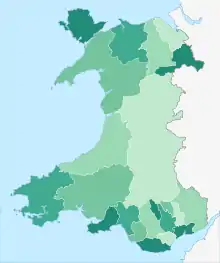 Map of the 22 principal areas of Wales | |
| Category | Unitary authorities |
| Location | Wales |
| Created |
|
| Number | 22 |
| Possible types |
|
| Government |
|
| Subdivisions | |
| This article is part of a series within the Politics of the United Kingdom on the |
| Politics of Wales |
|---|
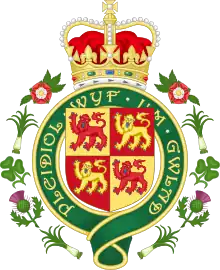 |
|
The monarch appoints a lord lieutenant as a representative in each of the eight preserved counties of Wales, which are combinations of principal areas retained for ceremonial purposes.
Subdivisions of Wales created for such purposes as the organisation of the National Health Service and the provision of police and emergency services are made up of combinations of principal areas. For example, the Dyfed–Powys Police force operates in the area covered by the principal areas of Pembrokeshire, Ceredigion, and Carmarthenshire as well as in Powys – the former three constituting the preserved county of Dyfed.
Principal areas
There are 22 principal areas in Wales. They came into being on 1 April 1996 by virtue of the Local Government (Wales) Act 1994 (1994 c. 19). Eleven are counties, including the cities of Cardiff and Swansea, and eleven are county boroughs (marked †), including the cities of Newport and Wrexham.[2][3][4]
Locations of each council headquarters are indicated by yellow markers.
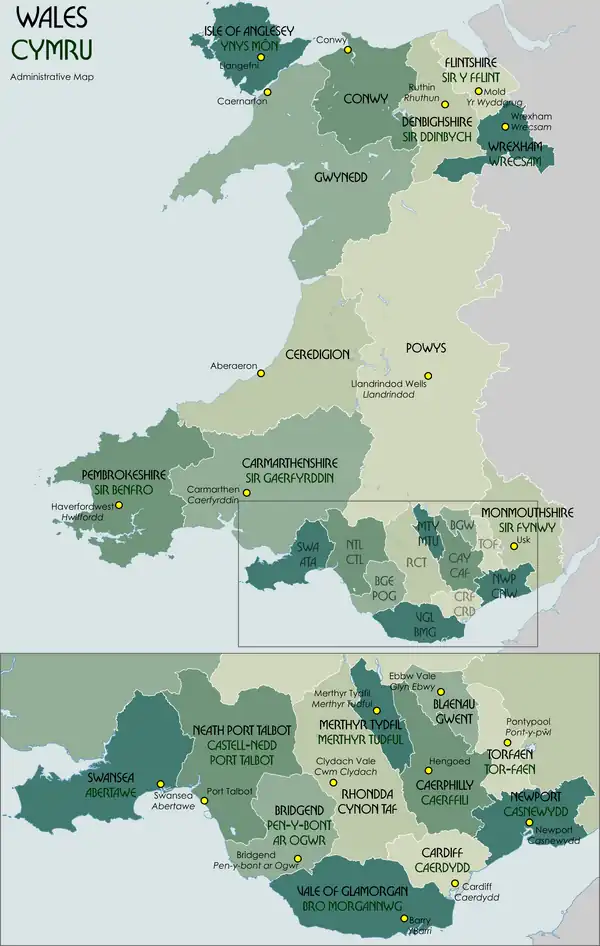 |
|
| Areas marked † are County Boroughs, while unmarked areas are Counties. Welsh-language forms are given alongside the English where they differ. | |
Name changes
The current names of certain unitary authority areas are different from those specified in the Local Government (Wales) Act 1994. The following changes took place, all with effect from 2 April 1996:[5]
- Conwy from Aberconwy and Colwyn
- Isle of Anglesey from Anglesey
- Gwynedd from Caernarfonshire and Merionethshire
- Ceredigion from Cardiganshire
- Neath Port Talbot from Neath and Port Talbot
Governance
Like councils throughout the UK, Welsh councils are made up of elected councillors. Exceptionally, because of political in-fighting and a history of poor performance, the executive functions of the Isle of Anglesey Council were temporarily taken over by commissioners appointed by the Welsh Government.[6] Elections planned for 2012 were delayed until 2013.[7]
Local government elections normally take place every four years, though the Wales Act 2017 prevented local government elections from taking place in the same year as elections to the Senedd (Welsh Parliament; Welsh: Senedd Cymru). Hence the Local Authorities (Change to the Year of Ordinary Elections (Wales) Order 2019 postponed the date of the May 2021 local elections to May 2022.[8]
Preserved counties of Wales
For ceremonial purposes of Lieutenancy and Shrievalty, Wales is divided into eight preserved counties. These were based on the counties (created by the Local Government Act 1972) which were used for local government and other purposes between 1974 and 1996.
Historic counties of Wales
The historic counties of Wales are ancient subdivisions of Wales, used for various functions for several hundred years. Pembrokeshire was formed as a county palatine in 1138. In the south east, Norman advancement led to the creation of marcher lordships, such as Glamorgan, which served as semi-autonomous administrative divisions, although these were not counties in the true sense as they lacked the formal structure. Some towns within these areas did, however, receive charters which outlined rights and duties in much the same way as a borough. Counties in the strict sense first appeared with the establishment of Cardiganshire and Carmarthenshire in the 1240s. In 1284 the Principality of Gwynedd was divided into three counties: Anglesey, Caernarvonshire and Merionethshire. Before the end of the century, Flintshire had also become a county, and thus nearly half the territory of Wales was under the rule of the English Crown. While the arrangement did not officially bring the marcher lordships in the South directly under the King's control, many such lordships were held by the King personally, although some remained under the semi-autonomous control of powerful local families. The formation of counties was completed under the Laws in Wales Act 1535, which created Montgomeryshire, Denbighshire, Radnorshire, Brecknockshire and Monmouthshire, many from existing marcher lordships now recreated as counties proper.
These 13 counties were the main administrative subdivisions of Wales from 1536 until the implementation in 1974 of the Local Government Act 1972, although the definition and role of the smaller county boroughs within the counties during that period saw considerable change, as it did across the United Kingdom.
Communities
At the lowest level of administrative subdivision in Wales are the communities, into which each principal area is subdivided. They may have elected community councils which perform a number of roles, such as providing local facilities, and representing their communities to larger local government bodies. Community councils are the equivalent of English parish councils. A community council may call itself a "town council" if it so wishes. The councils of three communities with city status – Bangor, St Asaph, and St Davids – are known as "city councils". Communities which are too small to have a council may have a community meeting instead: an example of direct democracy. The communities in the urban areas of the cities of Cardiff, Swansea and Newport do not have community councils.[9][10][11]
Police and fire services
Police forces
There are four police forces in Wales. These are:

1
2
3
4
|
|
Fire and rescue services
There are three fire and rescue services in Wales. The present Welsh fire services date from 1996. Each covers a number of principal areas. These are:

1
2
3
|
|
Regional bodies
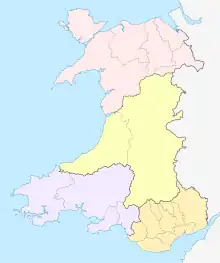
Corporate Joint Committees
The Local Government and Elections (Wales) Act 2021 allowed for the formation of Corporate Joint Committees (CJCs) made up of two or more principle areas.[12] Corporate Joint Committees have powers relating to economic well-being, strategic planning and the development of regional transport policies.[13]
In April 2021, four Corporate Joint Committees were created covering all of Wales:
City-regions
City regions are partnerships between local several authorities. As of April 2021, there are four statutory city region agreements in Wales:
Trunk road agents
Trunk road agents are partnerships between two or more principal councils in Wales for the purposes of managing, maintaining, and improving the network of Trunk roads (including any motorways) in their respective areas. Each trunk road agent can employ Welsh Government traffic officers.
There are two trunk road agents in Wales:
International Territorial Level
For statistical purposes, Wales is divided into statistical regions by the UK's Office for National Statistics, using the International Territorial Level geocode standard since 2021. Prior to 2021, as part of the European Union and Eurostat, the system used was Nomenclature of Territorial Units for Statistics (NUTS), with "UK" in any NUTS code replaced with "TL" for Territorial Level from 2021. Wales itself is a level 1 ITL region alongside Scotland, Northern Ireland and the 9 statistical regions of England, with the code for the Wales ITL 1 region being "TLL" ("UKL" under NUTS), which is subdivided as follows:
| ITL 1 | Code | ITL 2 | Code | ITL 3 | Code |
|---|---|---|---|---|---|
| Wales | TLL | West Wales and The Valleys | TLL1 | Isle of Anglesey | TLL11 |
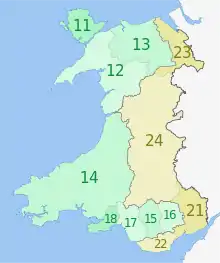 |
Gwynedd | TLL12 | |||
| Conwy and Denbighshire | TLL13 | ||||
| South West Wales (Ceredigion, Carmarthenshire, Pembrokeshire) | TLL14 | ||||
| Central Valleys (Merthyr Tydfil, Rhondda Cynon Taff) | TLL15 | ||||
| Gwent Valleys (Blaenau Gwent, Caerphilly, Torfaen) | TLL16 | ||||
| Bridgend and Neath Port Talbot | TLL17 | ||||
| Swansea | TLL18 | ||||
| East Wales | TLL2 | Monmouthshire and Newport | TLL21 | ||
| Cardiff and Vale of Glamorgan | TLL22 | ||||
| Flintshire and Wrexham | TLL23 | ||||
| Powys | TLL24 | ||||
History
Proposals to reform
Williams Commission
In April 2013, it was announced that a major review was to be undertaken into local government organisation in Wales, with a Commission on Public Service Governance and Delivery being established, to be chaired by Sir Paul Williams. First Minister Carwyn Jones said: "Since public sector budgets are likely to continue to tighten, and demand pressures grow, there is a clear need to examine how services can be sustained and standards of performance raised, so that people in Wales can continue to receive and influence the public services they need and value."[14]
The Commission reported on 20 January 2014. It recommended that the number of councils be reduced, through mergers rather than through boundary changes, from 22 to 10, 11 or 12; and suggested that the cost of merging the councils would be met through savings made within about two years.[15]
Wales' First Minister Carwyn Jones said: "This report addresses many issues that are critical at a time when the need for public services is outstripping the resources available to provide them. I have always been clear that the status quo is not an option. Change is inevitable and essential so that our public services can become more efficient, effective, accessible and responsive." Janet Finch-Saunders AM, shadow minister for local government, said: "What matters to the vast majority of hardworking families is not the intricate structures of local government, but knowing that services will be delivered in an efficient and cost effective way.... We believe that public services are best delivered locally so taxpayers can hold local representatives to account for what happens in their community." Rhodri Glyn Thomas, for Plaid Cymru, commented: "The weight of evidence presented to the Williams Commission shows that if the people of Wales are going to get the services they need and deserve then there has to be a radical improvement in the way public services are delivered."[15]
Draft Local Government (Wales) Bill
In response to recommendations made by the Williams Commission, the Welsh Government published a draft local government bill in November 2015.[16] The draft bill contained two proposals, one for eight local authorities and one for nine local authorities. The difference between the two proposals is related to North Wales (two or three local authorities). The bill did not propose names for the local authorities, only listing them by number as a combination of existing principal areas. Powys was not affected by either proposal. The changes were planned to take effect in April 2020.[17]
Eight local authorities model
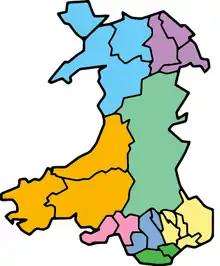
| Proposed local authority | Proposed area |
|---|---|
| Area 1 | Anglesey, Gwynedd, Conwy |
| Area 2 | Denbighshire, Flintshire, Wrexham |
| Area 3 | Ceredigion, Pembrokeshire, Carmarthenshire |
| Area 4 | Swansea, Neath Port Talbot |
| Area 5 | Bridgend, Rhondda Cynon Taff, Merthyr Tydfil |
| Area 6 | Cardiff, Vale of Glamorgan |
| Area 7 | Monmouthshire, Blaenau Gwent, Caerphilly, Torfaen and Newport |
| Powys | Powys |
Nine local authorities model
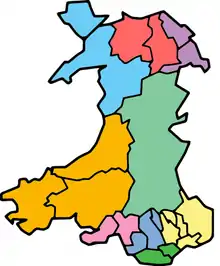
| Proposed local authority | Proposed area |
|---|---|
| Area 1 | Anglesey, Gwynedd |
| Area 2 | Conwy, Denbighshire |
| Area 3 | Flintshire, Wrexham |
| Area 4 | Ceredigion, Pembrokeshire, Carmarthenshire |
| Area 5 | Swansea, Neath Port Talbot |
| Area 6 | Bridgend, Rhondda Cynon Taff, Merthyr Tydfil |
| Area 7 | Cardiff, Vale of Glamorgan |
| Area 8 | Monmouthshire, Blaenau Gwent, Caerphilly, Torfaen and Newport |
| Powys | Powys |
2016 redrafting and abandonment
Following the 2016 assembly elections, First Minister Carwyn Jones announced that the proposals for local government reform would be taken "back to the drawing board" and that a new consensus on how to reform local government in Wales would be sought.[18] The merger plans were formally dropped in January 2017, when the Welsh Government instead began a consultation on wider reform of local governance arrangements. The number of councils are to remain as they currently are, unless two or more local authorities wish to pursue a voluntary merger.[19]
2017 white paper
A white paper titled "Reforming Local Government: Resilient and Renewed" was published in January 2017. It proposed the formation of regional bodies to encourage better collaboration between existing local authorities and a possible change in the electoral system used in local elections from "first past the post" to the "Single transferable vote" system.[19]
2018 green paper
A new green paper, "Strengthening Local Government: Delivering for People", was published in 2018.[20] The paper makes the case for a reduction of the number of local authorities from 22 to 10 and suggested three possible approaches, a system of voluntary mergers, a phased approach with authorities merging in either 2022 or 2026 or a comprehensive system of mergers to occur in 2022.[21]

| Proposed local authority | Proposed area |
|---|---|
| Area 1 | Anglesey, Gwynedd |
| Area 2 | Conwy, Denbighshire |
| Area 3 | Flintshire, Wrexham |
| Area 4 | Powys |
| Area 5 | Ceredigion, Pembrokeshire, Carmarthenshire |
| Area 6 | Swansea, Neath Port Talbot |
| Area 7 | Bridgend, Rhondda Cynon Taff, Merthyr Tydfil |
| Area 8 | Cardiff, Vale of Glamorgan |
| Area 9 | Caerphilly, Newport |
| Area 10 | Blaenau Gwent, Monmouthshire, Torfaen |
Local Government and Elections (Wales) Act 2021
A bill was introduced by the Welsh Government in November 2019 to reform local government in Wales. The bill contains provisions to reduce the voting age from 18 to 16 for local elections in Wales and will extend the franchise to include eligible foreign nationals. It extends the term of local councillors from four years to five years. The bill will allow local councils to decide to continue to hold elections under first past the post system or to switch to the single transferable vote system. The bill does not include provisions to restructure local councils but does contain mechanisms that can allow for two or more authorities to merge on a voluntary basis. It also creates a framework for joint regional coordination between local authorities through the formation of "Corporate Joint Committees".[22] The bill received Royal Assent in January 2021 and four Corporate Joint Committees covering all of Wales, were established the following month by statutory instruments.[23][24]
Cities
There are seven cities in total in Wales: in addition to the four principal areas with city status (Cardiff, Swansea, Newport and Wrexham), the communities of Bangor, St Davids and St Asaph also have the status. City status is granted by letters patent.
- Bangor – time indeterminate
- Cardiff – 1905
- Swansea – 1969
- St Davids – 1994
- Newport – 2002
- St Asaph – 2012
- Wrexham – 2022
St Asaph, as the seat of a bishopric, was historically referred to as a city, and was described as such in the 1911 Encyclopædia Britannica. The status was, however, not officially recognised for many years. When city status was restored to St Davids in 1994, St Asaph town council submitted a petition for the same purpose. The petition was refused as, unlike St Davids, there was no evidence of any charter or letters patent in the past conferring the status. Applications for city status in competitions in 2000 and 2002 were unsuccessful.[25] However, city status was finally granted to St Asaph in 2012 as part of the Queen's Diamond Jubilee celebrations:[26] St Asaph was selected "to recognise its wealth of history, its cultural contribution and its metropolitan status as a centre for technology, commerce and business". Wrexham was awarded city status as part of the Queen's Platinum Jubilee in September 2022.[27][28][29]
See also
- List of political parties in Wales
- List of Welsh principal areas
- List of Welsh areas by percentage of Welsh-speakers
- Welsh Government
- Geography of Wales
- List of communities in Wales
- List of electoral wards in Wales
- ISO 3166-2:GB, subdivision codes for the United Kingdom
- Local government in England
- Local government in Northern Ireland
- Local government in Scotland
- Political make-up of local councils in the United Kingdom#Wales
- Regions of Wales
Notes
- The Welsh Government may alternatively use "local authorities" instead of "principal areas".
References
Citations
- Local Government (Wales) Act 1994
- "Local Government (Wales) Act 1994". www.legislation.gov.uk. Archived from the original on 14 September 2017. Retrieved 8 May 2018.
- "No. 56573". The London Gazette. 21 May 2002. p. 6160.
- "Newport City Council". Newport City Council. 4 December 2010. Archived from the original on 9 December 2010. Retrieved 5 March 2011.
- "The Residuary Body for Wales (Levies) Regulations 1996". www.opsi.gov.uk. Archived from the original on 9 December 2009. Retrieved 8 May 2018.
- "Island council takeover to begin". BBC News. 17 March 2011. Archived from the original on 25 April 2012. Retrieved 8 May 2018.
- "Anglesey poll postponed for year". BBC News. 8 May 2018. Archived from the original on 13 May 2017. Retrieved 8 May 2018.
- Ruth Mosalski (24 September 2019). "The date of the next council elections in Wales has moved". Wales Online. Retrieved 17 October 2020.
- "Community councils". Cardiff Council. Archived from the original on 6 September 2018. Retrieved 7 April 2017.
- "Community/Town Council contact details". City and County of Swansea. 30 September 2003. Archived from the original on 8 April 2017. Retrieved 7 April 2017.
- "Community council contact details". Newport City Council. Archived from the original on 8 April 2017. Retrieved 7 April 2017.
- "Local Government and Elections (Wales) Act 2021".
- "The South West Wales Corporate Joint Committee Regulations 2021" (PDF).
- Local councils in Wales could be cut after review Archived 2013-04-19 at the Wayback Machine, BBC News, 19 April 2013.
- Williams Commission report calls for fewer councils Archived 2014-01-22 at the Wayback Machine, BBC News, 20 January 2014.
- "Consultations - beta.gov.wales". beta.gov.wales. Archived from the original on 30 May 2016. Retrieved 8 May 2018.
- "Local Government (Wales) Bill = Explanatory Memorandum incorporating the Regulatory Impact Assessment and Explanatory Notes" (PDF). Senedd. September 2015.
- "'Deeply unpopular' council merger plans scrapped". Monmouthshire Beacon.
- "Welsh Government - Local Government Reform White Paper unveiled by Mark Drakeford". gov.wales. 31 January 2017. Archived from the original on 17 October 2017. Retrieved 8 May 2018.
- "Strengthening Local Government: Delivering for people". GOV.WALES. 12 June 2018.
- "Number: WG34071 - Welsh Government Green Paper Consultation Document - Strengthening Local Government: Delivering for People" (PDF). Government of Wales. 20 March 2018.
- "Local Government and Elections (Wales) Bill". senedd.assembly.wales. November 18, 2019.
- "Local Government and Elections (Wales) Act 2021". Senedd. 18 November 2019. Retrieved 12 May 2021.
- "Local Government and Elections (Wales) Act 2021".
- Beckett, J V (2005). City Status in the British isles, 1830 – 2002. Aldershot: Ashgate Publishing. pp. 133–135. ISBN 0-7546-5067-7.
- "Three towns win city status for Diamond Jubilee". BBC News. 2012-04-18. Archived from the original on 2012-04-25. Retrieved 2012-04-18.
- "Queen's Jubilee: Wrexham becomes Wales' seventh city". BBC News. 2022-05-20. Retrieved 2022-05-21.
- "The City of Wrexham: History made as city status is granted". The Leader. 20 May 2022. Retrieved 2022-05-21.
- "Official – Wrexham is now a city". Wrexham.com. Retrieved 2022-09-01.
Sources
- CIA World Factbook 2002
External links
- Williams Commission report, January 2014
- LocalGov.co.uk – News updates on UK local government, including reorganisation
- Map of the UK counties and unitary administrations
- Map of all UK local authorities